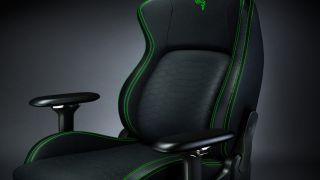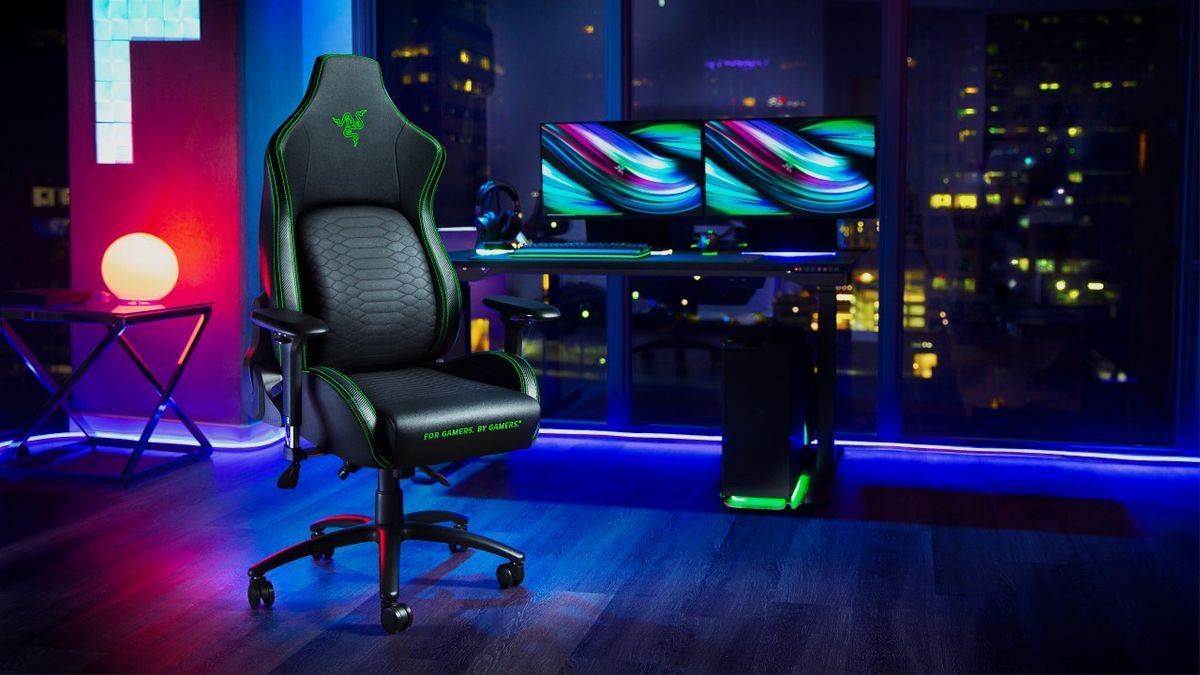12DOVE Verdict
Razer's first venture into gaming chairs is a great success: the Iskur is very comfortable, has great adjustability, and looks sleek - but it's expensive.
Pros
- +
Incredibly comfortable by default
- +
Excellent adjustability
- +
Lumbar support is terrific
- +
Cool design
Cons
- -
On the expensive side
- -
Couple of *tiny* wobbles in parts
- -
Seat is a little hard after a while
Why you can trust 12DOVE
Razer has started probing its way into other gaming hardware areas in the past year or so - the Razer Raptor was their first gaming monitor and oozed that Razer quality, for example - but not many of us would have expected them to make a contender for best gaming chair of 2020. Yet, here we are: the Razer Iskur has landed, and it's good. Very good.
Assembly & Design

First things first: the Iskur is a biggun. Even in unassembled box form, this is a huge, hefty unit with the box itself weighing around 30kgs. It's got that Razer quality and sense of humour even in packaged form, though, with the instruction 'leaflet' being a piece of card the size of the entire box, and a very cool and funny safety instruction graphic greeting you before you get the parts out to assemble the beast.
Speaking of which, there are several parts, but it's the usual suspects of armrests, main chair unit, wheels, base, and column that all need to be put together. The tools required come neatly packaged as well so you'll have everything you need right out of the box, and construction took me about an hour and a bit. The instructions are clear, even if they are slightly inconveniently posted on to that massive piece of card!

The design is very in-keeping with Razer's styles and aesthetics. A symphony in black and green, The multi-layered synthetic leather material is all black with different patterns across all parts, while the stitching is that famous Razer green which accentuates each rise and fall of the chair's form and each edge and design-form line. It's sleek, very pleasing, and has a great design overall.
It's not got over the top branding either: there's only one 'Razer' logo on the upper back, one Razer snake behind your neck, and the 'For Gamers, by Gamers' mantra on the front of the seat. This means that most of the branding symbols are obscured and thus increases the chair's ability to blend in with general office furniture and room styles. There's also a removable neck cushion too, which finishes the design if you prefer having an extra bit of softness on you. As a result, and as the pictures demonstrate, this isn't a gaming chair for PS4 or Xbox really - in the lounge or living room sense, anyway. This enters into the gaming chair market for the office or desk-bound end of the spectrum (naturally, as that's where you'll be playing on your PC's Razer setup).
Lastly, and unfortunately, I must report that there is no RGB present on the Iskur - though having to be plugged into a power source to provide energy for said RGBs might compromise the fluidity of chair movement somewhat.
Adjustability, Comfort, & Performance

This is the section where the Iskur starts to pull away from the pack, at least in its different take on comfort et al, and at best in its excellence in catering for it. For an early bit of context, I was starting to have a bit of back trouble from working from home and gaming in a more entry-level gaming chair this year, but this has all been fixed by introducing the Iskur to my day-to-day work and play setup.
The back and lumbar support are the main reasons for this. The shoulder support deviates from the racing chair aesthetic enough to ensure your shoulders are not shunted forward but rather supported from behind - for someone who's had operations on both shoulders, this is acutely noticeable. The height of the back support is also good enough for many different people, as Razer wanted to cater to all builds of person - the Iskur supports up to 299lbs / 136kg in weight and heights of 6 foot 2 / 190 cm.
The adjustable lumbar support is arguably the centrepiece of the Iskur's design, though. Instead of additional cushions or slightly-bulging lumbar systems, the Iskur deploys a cushioned and comfy trapdoor type system that can flip out (hinged behind your upper back and pushing out toward your lumber - naturally) to support your lower back as much as is necessary for you and your body. There's no one-size-fits-all system here, and the flexibility means you can get it just right. It does flip out incredibly hard and fast if you're not sitting on it though, and it will feel slightly odd initially, but you soon get used to it and appreciate the better posture it nudges you toward.

The armrests are the same excellent '4D' ones that feature across other premium gaming chairs, enabling you to move them back, forward, side-to-side, up and down, and rotated to wherever is best for your positioning. There are a couple of rattles from the armrests like they aren't quite fitted tightly enough, but this is likely from the design which allows so much manoeuvrability and customisation in their positioning.
My legs and behind have never been comfier too, and the Iskur doesn't try and cram you into its shape uncomfortable like a bucket seat; there's plenty of room for the legs to move and the rump is supported well with room to shift about should you need to. My only slight criticism here would be that the seat can get a bit hard on your posterior after long sessions.
You'll also have all the customisation options you need in the chair itself, in terms of height, tile and recline, and so on. It didn't take long for me to find a comfy position with the Iskur, though I have enjoyed the ability to carry on tinkering with it since, given the customisation available to me.
Using the chair is, unsurprisingly, a joy because of all this. It's comfy, supports me well, and I no longer have that back ache from a cheaper chair. It holds its position too: there are no gentle rolls away from the desk on the wheels from you shifting your weight slightly, even on my hard floor protector.
All in, when sitting at your desk and whatever you play on - be it one of the best gaming laptops, or one of the best gaming PCs like the ASUS GA15 that I use - it's a genuinely awesome chair. It will have you covered, however you prefer to sit, or even however you should be sitting (such is its success in promoting good posture).
Overall - should you buy it?

Compared to my previous mid-range chair, the Razer Iskur is an immense upgrade. This has allowed me to see its benefits directly and makes recommending it even easier than it would be with no reference point. It's a sizeable investment at $499.99 / £499.99, but it's not outlandishly more expensive than other premium gaming chairs.
If you're in the market for a premium chair to be your first or to upgrade with, then this could very well be the best option. It's an enormously successful first gaming chair from Razer, and the Iskur will be making a swift trip to near the top of our best-of list for gaming seats, that's for sure.
Rob is the Deputy Editor of sister site, TechRadar Gaming, and has been in the games and tech industry for years. Prior to a recent stint as Gaming Editor at WePC, Rob was the Commissioning Editor for Hardware at 12DOVE, and was on the hardware team for more than four years, since its inception in late 2018. He is also a writer on games and has had work published over the last six years or so at the likes of Eurogamer, RPS, PCGN, and more. He is also a qualified landscape and garden designer, so does that in his spare time, while he is also an expert on the virtual landscapes and environments of games and loves to write about them too, including in an upcoming book on the topic!
Cult classic racing series returns 18 years after its once-final entry on Xbox 360 to 95% overwhelmingly positive Steam reviews
Hogwarts Legacy gets official PC modding support in time for the wizarding RPG’s 2-year anniversary, but console players are feeling left out
One of the oldest ongoing JRPG series adds its divisive gacha spinoff to the live service graveyard after barely a year

